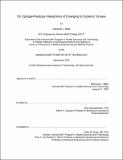On Epitope-Paratope Interactions of Emerging to Endemic Viruses
Author(s)
Miller, Nathaniel L.
DownloadThesis PDF (45.79Mb)
Advisor
Sasisekharan, Ram
Terms of use
Metadata
Show full item recordAbstract
For clinicians, scientists, and public health officials, it’s a challenge to manage the spectrum of viruses across the world. The addressable viral spectrum ranges from emerging viruses such as Nipah virus (NiV), which appear sporadically as local zoonotic outbreaks with high mortality, to continually-evolving endemic viruses such as influenza A (flu). Meanwhile, SARS-CoV-2 is currently transitioning from an emerging to an endemic virus with unknown evolutionary potential. Though highly differentiated, these three viruses present a common challenge to society in the need to continually prepare for and rapidly respond to new outbreaks, novel variants, and persistent antigenic drift. Through dedication of resources and tools toward this end, society can prevent significant annual morbidity.
Viruses present numerous surfaces known as epitopes that are recognized by the human host immune system upon infection. Infected hosts develop antibodies that bind virus epitopes via the antibody’s paratope domain in an epitope-paratope interaction (EPI). EPIs are key aspects of the dynamic interplay between the virus and the host immune response to neutralize the virus. Studying EPIs enables us to better understand viral pathogenesis, map viral evolution due to antigenic pressure, and rationally develop vaccines and therapeutics.
In this thesis, we present a series of EPI analyses of NiV, Flu, and SARS-CoV-2 that enrich our understanding of these viruses and serve as the basis for therapeutic antibody design, optimization, and repurposing. In particular, our work focuses on antibody epitope complexity, such as epitopes that include N-glycans or epitopes for which allostery and epistasis resulting from higher-order protein structure contribute to antibody escape. We additionally examine the roles of epitope overlap and orthogonality within polyclonal responses to a given antigen. Through these investigations, we develop EPI analytical methods and tools with applications across the viral spectrum. We apply these methods to identify repurposing targets for an anti-HIV antibody, chart antigenic space for the SARS-CoV-2 receptor-binding and N- terminal domains, and rapidly model escape of the Omicron BA.1 variant from therapeutic antibodies in the days immediately following its emergence.
Date issued
2022-09Department
Harvard-MIT Program in Health Sciences and TechnologyPublisher
Massachusetts Institute of Technology